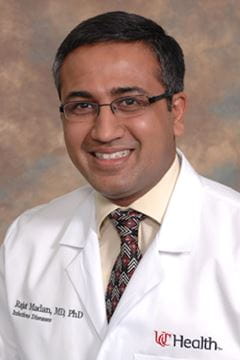Research Faculty
Theresa Alenghat, VMD, PhD
Professor, UC Department of Pediatrics
theresa.alenghat@cchmc.org Sandra Andorf, PhD
Assistant Professor, UC Department of Pediatrics
sandra.andorf@cchmc.org Koichi Araki, DVM, PhD
Division of Infectious Diseases
koichi.araki@cchmc.org Yuriy Baglaenko, PhD
Member, Division of Human Genetics
yuriy.baglaenko@cchmc.org Amélie Collins, MD, PhD
Attending Physician, Division of Neonatology
amelie.collins@cchmc.org Senad Divanovic, PhD
Director of Admissions, Immunology Graduate Program
senad.divanovic@cchmc.org Ajay Dixit, MSc, PhD
Member, Division of Gastroenterology, Hepatology and Nutrition
ajay.dixit@cchmc.org Maria E. Fields (Moreno-Fernandez), PhD
Member, Division of Gastroenterology, Hepatology and Nutrition
maria.fields@cchmc.org Marie-Dominique Filippi, PhD
Member, Division of Experimental Hematology & Cancer Biology
marie-dominique.filippi@cchmc.org H. Leighton "Lee" Grimes, PhD
Director, Cancer Pathology Program, Division of Experimental Hematology & Division of Pathology
lee.grimes@cchmc.org Gurjit "Neeru" Khurana Hershey, MD, PhD
Director, Division of Asthma Research
gurjit.hershey@cchmc.org Igal Ifergan, PhD
Assistant Professor, Division of Molecular Genetics
igal.ifergan@uc.edu Michael P. Jankowski, PhD
Professor, UC Department of Pediatrics
michael.jankowski@cchmc.org Courtney L. Jones, PhD
Member, Division of Experimental Hematology and Cancer Biology
courtney.jones@cchmc.org Michael B. Jordan, MD
Professor, UC Department of Pediatrics
michael.jordan@cchmc.org Theodosia A. Kalfa, MD, PhD
Co-Director, Erythrocyte Diagnostic Laboratory
theodosia.kalfa@cchmc.org Daniel Lucas, PhD
Member, Division of Experimental Hematology & Cancer Biology
daniel.lucas@cchmc.org Rajat Madan, MBBS, PhD
Member, Division of Gastroenterology, Hepatology and Nutrition
rajat.madan@uc.edu Punam Malik, MD
Director, Cincinnati Comprehensive Sickle Cell Center
punam.malik@cchmc.org Alexander G. Miethke, MD
Medical Director, Liver Transplant Program
alexander.miethke@cchmc.org Linde A. Miles, PhD
Member, Division of Experimental Hematology & Cancer Biology
linde.miles@cchmc.org Sean R. Moore, MD, MS
Division Director, Division of Gastroenterology, Hepatology and Nutrition
sean.moore@cchmc.org Takahisa Nakamura, PhD
Associate Professor, UC Department of Pediatrics
takahisa.nakamura@cchmc.org Joseph S. Palumbo, MD
Director, Comprehensive Thrombophilia Center
joe.palumbo@cchmc.org Ronald Panganiban, PhD
Member, Division of Asthma Research
ronald.panganiban@cchmc.org Chandrashekhar Pasare, DVM, PhD
Professor, UC Department of Pediatrics
chandrashekhar.pasare@cchmc.org Marc E. Rothenberg, MD, PhD
Director, Division of Allergy and Immunology
marc.rothenberg@cchmc.org Nathan Salomonis, PhD
Associate Professor, UC Department of Pediatrics
nathan.salomonis@cchmc.org Grant Schulert, MD, PhD
Associate Professor, UC Department of Pediatrics
grant.schulert@cchmc.org Wenhai Shao, PhD
Associate Professor, UC Department of Internal Medicine
shaowi@ucmail.uc.edu Paul Spearman, MD
Vice Chair, Clinical and Translational Research and Education, Department of Pediatrics
paul.spearman@cchmc.org Daniel T. Starczynowski, PhD
Katherine Stewart Waters Endowed Chair of Hematologic Malignancies
daniel.starczynowski@cchmc.org Tamara Tilburgs, PhD
Associate Professor, UC Department of Pediatrics
tamara.tilburgs@cchmc.org Ty D. Troutman, PhD
Assistant Professor, UC Department of Pediatrics
ty.troutman@cchmc.org Kelli L. VanDussen, PhD
Assistant Professor, UC Department of Pediatrics
kelli.vandussen@cchmc.org Stephen N. Waggoner, PhD
Associate Professor, UC Department of Pediatrics
stephen.waggoner@cchmc.org Yunguan Wang, PhD
Member, Division of Pediatric Gastroenterology, Hepatology and Nutrition
yunguan.wang@cchmc.org Sing Sing Way, MD, PhD
Pauline and Lawson Reed Chair, Division of Infectious Diseases
singsing.way@cchmc.org Matthew T. Weirauch, PhD
Member, Center for Autoimmune Genomics and Etiology, Divisions of Human Genetics, Biomedical Informatics, and Developmental Biology
matthew.weirauch@cchmc.org 
















































